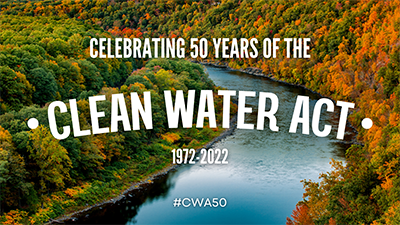Delaware • New Jersey • Pennsylvania
New York • United States of America
 |
On October 18, 2022, the Clean Water Act (CWA) turns 50! This important law provided the ability for the federal government to regulate pollution and, most importantly, provided the necessary funding to improve wastewater infrastructure.
Before regulation, rivers, including the Delaware, were treated as open sewers, leading to dead zones with no dissolved oxygen, unsuitable habitat for fish and other aquatic life. In the early-mid 1900s, the Delaware River Estuary around Philadelphia, Camden and Wilmington was so polluted from trash, raw sewage and factory discharges that it ate paint off of ships and could be smelled from the air.
Here in the Delaware River Basin, pollution regulation got a head start, thanks to the Delaware River Basin Commission (DRBC). Formed in 1961, the DRBC's compact gave it the authority to control future pollution and abate existing pollution in basin waters. The Commission got to work right away, issuing water quality regulations in 1967 and creating waste load allocations in 1968, several years before the passage of the Clean Water Act.
The combination of the DRBC's regulatory efforts, federal funding to improve wastewater infrastructure, coordinated interstate and federal water quality management and practical improvements by wastewater treatment plant engineers and operators led to a remarkable recovery. The CWA was a vital part of the restoration of the Delaware River.
Today, a river once considered dead is reborn. Resident fish thrive in the river's urban section, and migratory fish can travel through these waters to spawn upstream. The Delaware's overall water quality is much improved, and people are returning to its banks to be reconnected to this important resource. We all can – and should – celebrate a cleaner Delaware River!
But, for the Delaware River to be fully fishable and swimmable – the stated goals of the CWA – we still have work to do.
In 2017, the DRBC initiated its Aquatic Life Designated Use Study to determine whether higher dissolved oxygen levels are achievable and feasible in the urban portion of the Delaware River Estuary to better support fish propagation (reproduction and juvenile development), which is protected in the rest of the river. The project just reached an important milestone with the publication of the Draft Analysis of Attainability: Improving Dissolved Oxygen and Aquatic life Uses in the Delaware River Estuary in September 2022.
The Commission is also studying whether recreation can be improved in the river's urban waters to support primary contact recreation, i.e. swimming and other water-immersible activities. Currently, these waters are designated for secondary contact, think fishing and boating, due to high bacteria levels from combined sewer overflows, wildlife and stormwater runoff. The rest of the river meets the higher designation.
The DRBC recognizes and celebrates the 50th Anniversary of the Clean Water Act and its transformative, positive impact on the quality of our Nation's waters. The Commission is committed to working collaboratively with our co-regulators and basin stakeholders toward continued water quality improvements in order to successfully support Clean Water Act goals for the interstate Delaware River.
Copyright © Delaware River Basin Commission,
P.O. Box 7360, West Trenton, NJ 08628-0360
Phone (609)883-9500; Fax (609)883-9522
Thanks to NJ for hosting the DRBC website